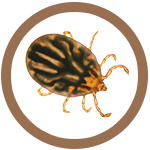JULY 19, 2018
'Tis the Season
By Dr. Jack Walkenhorst
Hot weather is here and that means fleas and tick season is at its height. Fleas and ticks can be a problem anytime,
but they’re most prevalent when the temperature is consistently above freezing. In Greater Cincinnati,
that can be as early as March and last well into November.

The good news is that the measures to keep your pet free from the misery of fleas and ticks are simple:
- Comb and thoroughly check your pet’s body after every trip outside
- Keep your yard mowed, raked, and free from tall grasses and weeds
- Follow your veterinarian’s recommendation for one of the many effective topical or oral prescription flea/tick medications. (Never use an over-the-counter product without consulting your veterinarian!) Although fleas and ticks are most prevalent in the warm summer months, it’s highly recommended that flea and tick preventatives be used all year long.
There’s no reason for any pet to suffer during flea and tick season!



